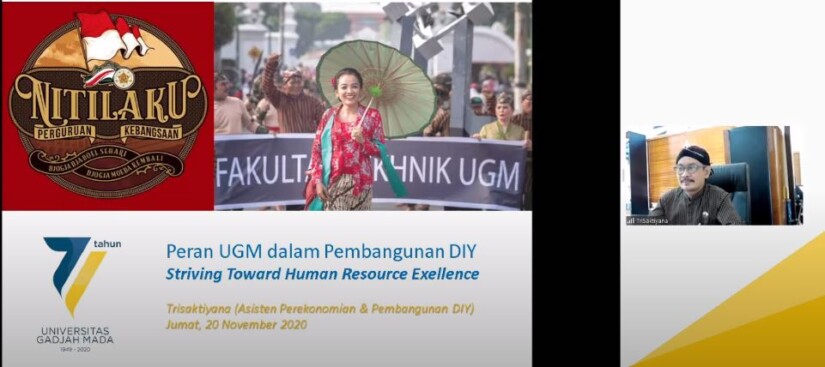
In March 2020, the number of impoverished population in DIY reached 475,072 thousand people or 12.28 of the total population from 3.2 million people. This percentage of impoverished people is still above the national average of 9.78 percent. Gunung Kidul Regency is considered as the largest area of impoverished people. The total is about 18.30 percent, while Kulon Progo 17.12 percent and Bantul 13.43 percent.
“The ones which are below the national average are only Sleman and Yogyakarta City,” said UGM Director of Community Service, Prof. Irfan Priyambada. He conveyed this statement in an online seminar held by the UGM Council of Professors (DGB) entitled The Roles of Universitas Gadjah Mada University for DIY Development on Friday (20/11).
Irfan added that until now, poverty is one of the hardest development problems in our country. However, the government made various programs to alleviate poverty. He also said the root of low-income families must be identified properly to get a resolution through more appropriate programs. “So far, we haven’t found the root of the poverty problem, so handling is not quite precise. Although still, there are efforts to provide stimulant funds for low-income families,” said Irfan.
According to Irfan, UGM also has a role in alleviating low-income families in DIY through the program of UGM-SCS CEL. One of the student work programs explores the causes of poverty rates and the MSMEs assistance program. He admitted that it is necessary to create new jobs for low-income families jointly.
Irfan mentioned an example of research from UGM SCS CEL students on low-income families of coconut sugar tappers in the mountainous area of Menoreh Kulon Progo. They are getting poorer as they are getting older. “They are getting poorer when they get older because the tasters are old enough to process it. In the past, it could be possible for him to tumble 10-15 trees, now it turns out only five trees,” he said.
Irfan stated that UGM also carried out another activity to encourage people’s interests in agriculture again.
“We, UGM Faculty of Agriculture, has rebuilt people’s interests in agriculture for developing soybeans. This strategy utilized inoculation technology by directing academicians, both professors, doctors, and students,” he said.
Nevertheless, according to Irfan, indeed, UGM can do it independently. But still, we need to involve other campuses in Yogyakarta to do a similar thing or collaborate in poverty alleviation programs.
Tri Saktiana, as Yogyakarta Secretariat Economic Assistant, said that apart from the problem of poverty, Yogyakarta is also challenging slowing economic growth due to the Covid-19 pandemic, which has affected the DIY economy. “In the first quarter, we minus 0.16, and in the second quarter, minus 6.72, then in the third quarter, we have minus 2.84. We have negative in two consecutive quarters. It means we are facing a recession,” he said.
Although there is an increasing number of percentages, the Yogyakarta Human Development Index (HDI) clashes with the national average. He said the HDI is at 79.99, while the national figure is 71.92. Besides, the highest national Cultural Development Index is 73.39, compared to the national average of 53.74.
Tri Saktiana also revealed that DIY’s economic growth is currently strengthened by the household scale, agriculture, tourism, and education sectors. Hence, she hoped UGM could become a leader for Yogyakarta’s economic growth through education, research, and community service programs.
Author: Gusti Grehenson
Translator: Natasa A

